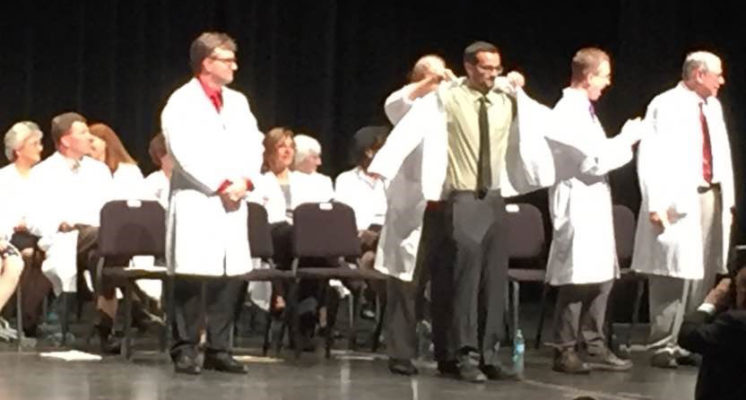It wasn’t until my mid-twenties that I discovered that I had three major health conditions. And to say that it took a long and painful road to get there is quite an understatement. The road involved two years of pain, headaches, heart palpitations, shortness of breath and a multitude of doctors’ and ER visits. I was told over and over again that anxiety and depression were to blame.
I later found out that it was a perfect storm of sorts – a trifecta of Chiari malformation, pectus excavatum and Ehlers-Danlos syndrome.
Chiari Malformation Diagnosis
I discovered I had Chiari malformation after many months of frustration. I kept going to my local adult hospital’s emergency department, complaining of headaches. They would give me medications and nothing would work. Narcotics were offered and I would refuse them due to my family’s history with addiction.
Because multiple CT scans showed that nothing was wrong, my primary doctor suggested getting an MRI. It took many steps and going back and forth before a local adult neurologist’s office would agree to perform one. They dismissed me because I was young and told me to come back in six months if I was still in pain. I wouldn’t accept this answer. I was in so much pain that I could get barely out of bed, let alone take care of my kids.
Eventually the MRI was ordered and it showed that I was diagnosed with Chiari malformation. I got referred to a local adult brain and spine center. There I learned that I had significant blockage of my spinal fluid and a retroflexed odontoid in my neck, which can compress the brain stem. My best course of treatment was brain surgery to treat it, which I had in August of 2015.
Pectus Excavatum Diagnosis
I first learned that I had pectus excavatum after about 12 visits in one month to a local adult hospital. I was looking for the results of an X-ray I’d had on MyChart when I saw “pectus excavatum” listed as a diagnosis. No one ever told me that I had the condition. So I did what anyone would do – I Googled it.
Through my searching, I learned that having pectus excavatum meant that I had a depression in my breastbone, which is due to an abnormal growth of the cartilage. It can range from very mild to severe. On the more severe side, the compression can impair heart and lung function. This explained so many of my struggles – not just in the last couple of years, but throughout my entire life. I always knew my chest was different, but didn’t know that it was affecting me physically. I remember being in gym class and getting in trouble for being “lazy” because I couldn’t run. At my recent worst, I couldn’t stand up long enough to take a shower. Keeping up with my kids was impossible.
As I was Googling pectus, I came across Cincinnati Children’s website and learned that they treat adults with the condition. So I scheduled an appointment with Dr. Garcia. He explained that a normal chest wall has a Haller index depth of 2.5. Surgery is typically recommended for those who have a 3.4 or greater. Mine was 6.4 and my heart was essentially flattened like a pancake. It’s no wonder I was having problems functioning.
Pectus Excavatum Surgery: The Nuss Procedure
When I learned how severe my pectus was, surgery was a no brainer for me. I wanted to be the best I could be for my kids. And my quality of life was non-existent. Dr. Garcia explained that the procedure would involve placing two titanium bars under my sternum to push it forward and help reform the shape of the chest. And that recovery would take about six weeks to three months to fully heal.
I’m not going to lie. Recovery following surgery was one of the hardest things I’ve ever done. But it was totally worth it. I’ve gotten my life back. I can now get up our stairs without having to rest on the landing at the top of our stairs. I can breathe. My heart isn’t pounding in my chest wall at all times. I still have mild numbness, nerve regrowth, and of course some discomfort if I don’t complete the stretching exercises Dr. Garcia told me to do on a daily basis. I mean titanium doesn’t belong there (haha!).
Ehlers-Danlos Diagnosis
Dr. Garcia also informed me that patients who have pectus may also have other conditions like scoliosis, mitral valve prolapse, and connective tissue disorders. So he screened me for those, and subsequently referred me to the genetics department.
They diagnosed me with Ehlers-Danlos syndrome, which is a connective tissue disorder and can cause a lot of pain. It is a life-long condition that effects all of the collagen in the body, including organs and ligaments. I now understood why my joints, knees and hips always hurt. I just assumed that I was tired from going to school and working.
Finally Getting My Life Back on Track
Receiving three diagnoses over the course of a year was crazy. I always knew I wasn’t “normal”, but this was a lot to take in! However, following multiple surgeries and treatment for EDS, I feel like I’m finally getting my life back on track. I can function and be an active participant in my kids’ lives.
And because pectus often runs in families, Dr. Garcia wanted to screen my children for it as well. He determined that my son has it. It’s comforting knowing that his was caught early and he won’t suffer through decades of pain like I did.
By sharing my story, I hope to bring awareness to all of three of these conditions, including how serious pectus can be. I realize that doctors aren’t going to catch everything that’s going on with everyone, but I do feel like my diagnoses should have been caught earlier than they were, even in the rural part of Ohio where we lived. I hope that this will help other children or even adults. Trust your instincts and speak up when you think something isn’t right. You know your body better than ANYONE. My pectus wasn’t life-threatening, but it definitely took my life from me.
To learn more about our Chest Wall Center, which treats pectus excavatum, please call 513-803-1062 or email chest-wall-center@cchmc.org.






Nicole,
Do you have hyper mobility type EDs? Have you had problems with pain since your Nuss repair? My daughter has Eds and POTs and Pectus. Her Haller index is 4.65. She is considering the repair, but surgeon warned her that there is a good chance she might develop chronic pain due to her EDs.